If you're learning Spanish, grammar tools can help you improve your writing, understand sentence structure, and avoid common mistakes. This guide lists 10 free online Spanish grammar tools that cater to different skill levels - beginner, intermediate, and advanced. Each tool offers unique features like grammar correction, style suggestions, or interactive exercises. Here's a quick summary of what's covered:
- LexiCheck: AI-powered grammar checker with high accuracy and detailed feedback.
- LanguageTool: Multi-functional tool with grammar, style, and paraphrasing features.
- SpanishChecker: Focused on non-native learners with targeted error explanations.
- Reverso: Combines grammar checks with contextual translations and vocabulary help.
- Scribbr: Advanced grammar checker with options for paraphrasing and proofreading.
- My Stilus: Detailed grammar, style, and typography feedback with regional Spanish support.
- Practical Spanish: Offers lessons and quizzes paired with video examples.
- Forvo: A pronunciation tool with audio recordings by native speakers.
- Microsoft Word Spanish Grammar Check: Built-in grammar checker for Spanish text.
- Spanish Language Learning Apps Grammar Section: Interactive grammar lessons via apps like LingoDeer and SpanishPod101.
These tools are free to use, though some offer premium upgrades for additional features. Each tool is accessible online or via apps, making it easy to fit grammar practice into your routine. Whether you're a beginner learning basic rules or an advanced learner refining your writing, there's something here for everyone.
Quick Comparison
| Tool | Key Features | Best For | Accessibility |
|---|---|---|---|
| LexiCheck | Grammar/spelling checks, AI chatbot | All levels | Browser-based |
| LanguageTool | Grammar/style checks, integration with apps | All levels | Web, apps, browser extensions |
| SpanishChecker | Targeted feedback for non-native speakers | All levels | Web-based |
| Reverso | Grammar checks, translations, vocabulary help | All levels | Web, apps |
| Scribbr | Advanced grammar checks, paraphrasing | All levels | Web-based |
| My Stilus | Grammar, style, typography, regional variants | All levels | Web, MS Word add-in |
| Practical Spanish | Lessons, quizzes, video examples | All levels | Web-based |
| Forvo | Pronunciation recordings by native speakers | Beginners/Intermediate | Web, apps |
| MS Word Grammar Check | Built-in grammar checker for Spanish | All levels | Word app, Office 365 |
| Language Apps | Gamified lessons, quizzes, AI tutors | All levels | iOS, Android apps |
Each tool has strengths, so try a few to find the best fit for your learning style.
Grammar and Spell Check Tools I Spanish Grammar Series
How to Pick the Right Spanish Grammar Tool
Choosing the right tool for practicing Spanish grammar online doesn’t have to be overwhelming. Start by selecting a tool that aligns with your skill level. If you’re a beginner, look for platforms that offer quick wins to build confidence. Advanced learners, on the other hand, should prioritize tools that provide detailed feedback and more complex exercises [2].
Think about your learning goals. Are you focused solely on grammar rules? Then a grammar-specific platform might be your best bet. If you’re aiming for broader language skills, opt for tools that integrate grammar with vocabulary, listening, and speaking practice. Next, consider how you learn best. Visual learners might prefer tools with images and simple, user-friendly layouts. Auditory learners should look for features like pronunciation guides and audio feedback. Meanwhile, kinesthetic learners often benefit from interactive activities that encourage hands-on participation.
A tool’s ease of use is another key factor. An intuitive and well-designed interface can make learning smoother and more enjoyable [6]. Pay close attention to the quality of feedback the tool provides. Some platforms only point out errors, while others go further by explaining corrections in detail and offering guidance to help you understand the rules behind them [3][7].
Another consideration is whether the tool supports specific Spanish dialects. If you’re learning a particular variant - like Mexican or Castilian Spanish - choose a platform that tailors its corrections and explanations to that dialect [7]. Practical features, like text length limits, also matter. Tools with restrictive character limits might hinder your ability to practice effectively [5].
Here’s a quick breakdown of features to evaluate when comparing tools:
| Tool Feature | What to Look For | Why It Matters |
|---|---|---|
| Skill Level Match | Beginner-friendly tips or advanced analysis | Ensures the tool meets your current needs |
| Feedback Quality | Detailed explanations and learning support | Helps you grasp grammar rules, not just fixes |
| Interface Design | Clean, easy-to-navigate layout | Reduces frustration and keeps learning fun |
| Language Variants | Support for your specific Spanish dialect | Provides accurate corrections and context |
| Character Limits | Enough space for practical use | Avoids interruptions during practice |
| Integration Options | Compatibility with your existing tools | Makes learning more seamless |
Testing different platforms is a smart way to find the best match for your learning style. Many tools offer free trials or basic versions, so take advantage of these to explore their features before committing. As you use a tool, keep track of your progress to identify areas where you need more practice [1].
1. LexiCheck
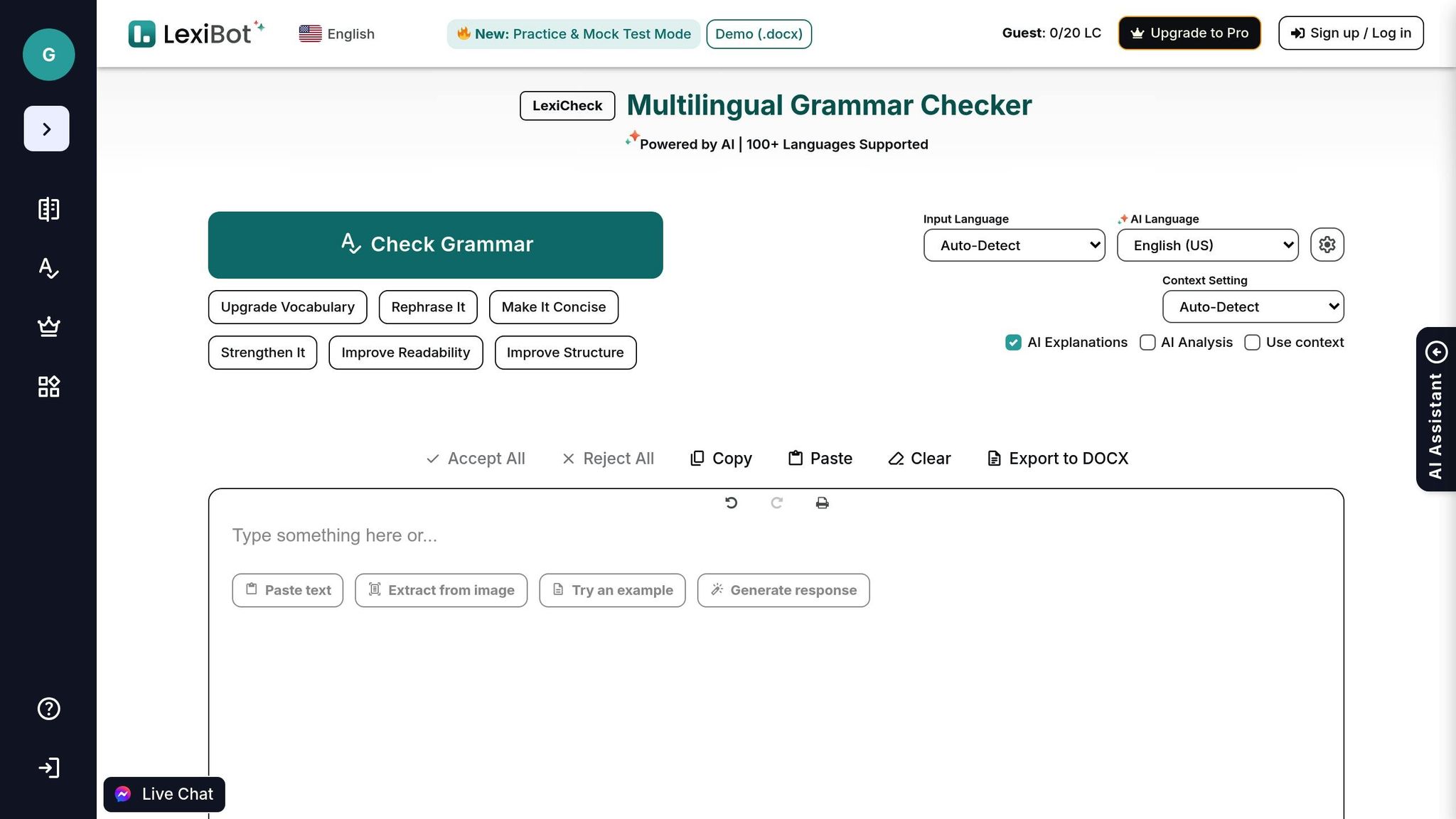
LexiCheck is an AI-driven online grammar tool designed to help language learners sharpen their Spanish writing skills. With support for over 100 languages - including Spanish - it’s a go-to resource for more than 350,000 learners and educators worldwide [8]. Here’s a closer look at what it offers.
Grammar Correction Quality
LexiCheck identifies grammar and spelling errors with an impressive 95% accuracy rate. Errors are highlighted in red, while suggestions are marked in green, making it easy to spot and address mistakes quickly [8]. To deepen understanding, it provides explanations for each correction, reinforcing key grammar rules. Plus, the platform includes an AI-powered chatbot for answering specific grammar-related questions.
Type of Tool
At its core, LexiCheck is a grammar and spell checker. Users can paste Spanish text into the platform, review corrections, and even export suggestions as DOCX files [8]. This makes it ideal for students working on essays or professionals drafting emails.
Suitability for Proficiency Levels
LexiCheck caters to a wide range of users. Beginners benefit from straightforward explanations, while advanced learners can rely on it to catch more subtle errors [8].
Accessibility
Accessible through any web browser, LexiCheck works seamlessly on all devices [4]. It offers a free version for quick grammar checks without requiring a login. For those needing unlimited corrections, an upgraded version is available [4].
Next, let’s dive into another tool with its own standout features.
2. LanguageTool
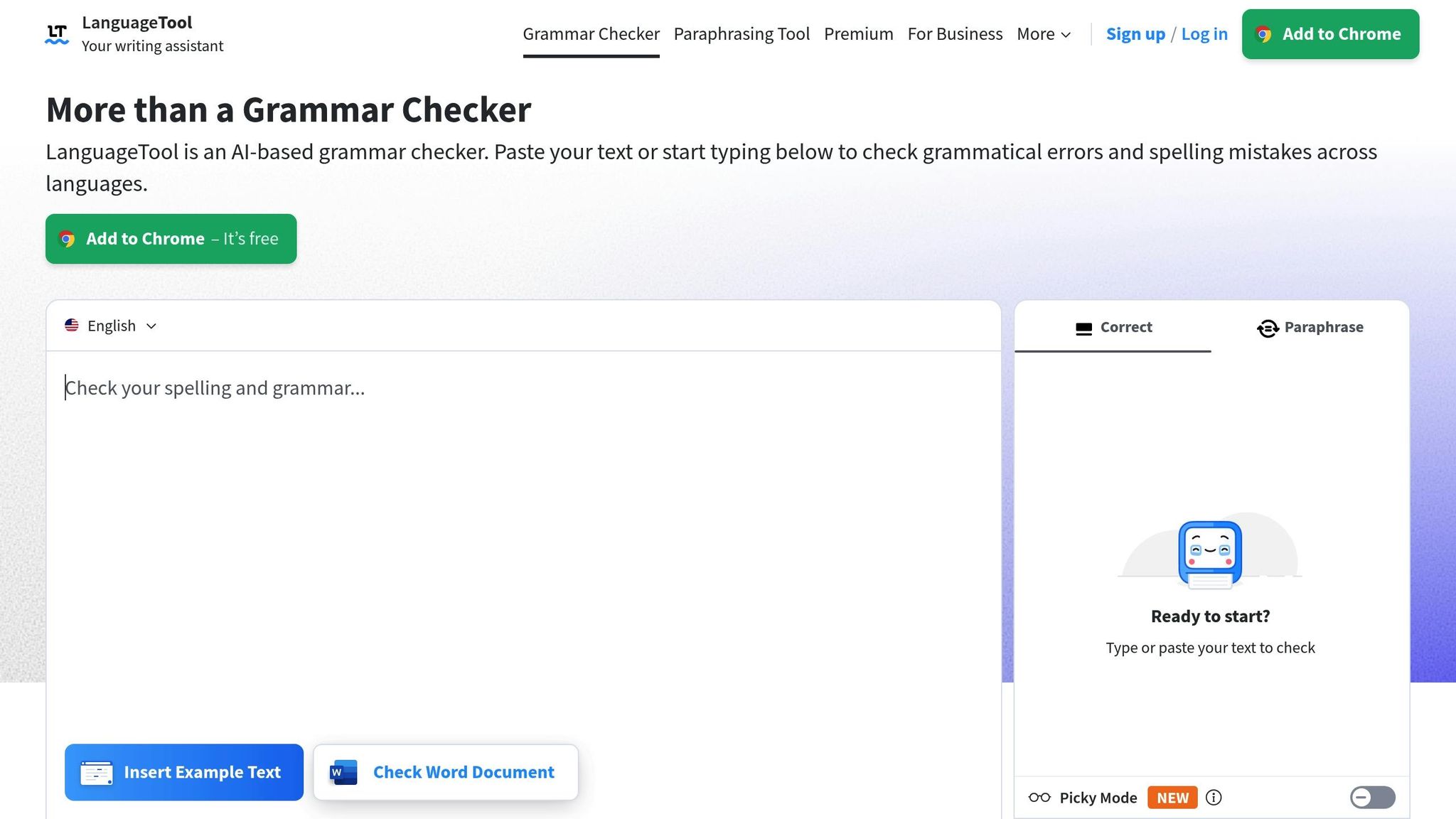
LanguageTool is a widely-used writing assistant, supporting over 4 million users globally[9]. This AI-driven tool goes beyond simple spell-checking, offering in-depth analysis of Spanish text across grammar, style, and more.
Grammar Correction Quality
LanguageTool uses a clever color-coding system to highlight issues: red for spelling errors, yellow for grammar mistakes, and blue for style suggestions[9].
It’s particularly good at spotting subtle grammar issues, like redundant phrases, incorrect word choices, and overused expressions. The free version handles basic mistakes, while the Premium plan digs deeper, addressing complex grammar and style nuances[9].
Type of Tool
At its core, LanguageTool is a grammar and spell checker. But it doesn’t stop there - it also offers style suggestions and a paraphrasing tool to help users rephrase sentences more naturally[9].
Suitability for Proficiency Levels
LanguageTool caters to a wide range of users. Beginners can rely on its clear visual cues and simple suggestions to correct errors. Intermediate learners benefit from its style recommendations to improve the flow of their writing. Advanced users will appreciate its ability to refine grammar and analyze style, helping them achieve a more polished, near-native level of Spanish.
Accessibility
This tool is incredibly versatile in how it can be accessed. You can use it through a web editor, browser extensions (available for Chrome, Firefox, Edge, and Safari), desktop apps for macOS and Windows, and a mobile app for iOS. It also integrates seamlessly with platforms like Google Docs, Microsoft Word, LibreOffice, and popular email services[9].
While basic features are available without an account, signing up for a free account unlocks extra perks like a personal dictionary, writing statistics, and a distraction-free interface. With over 3 million users on Chrome alone, LanguageTool has proven itself as a reliable and accessible resource for Spanish grammar practice, making it a valuable tool for learners at all levels[9].
3. SpanishChecker
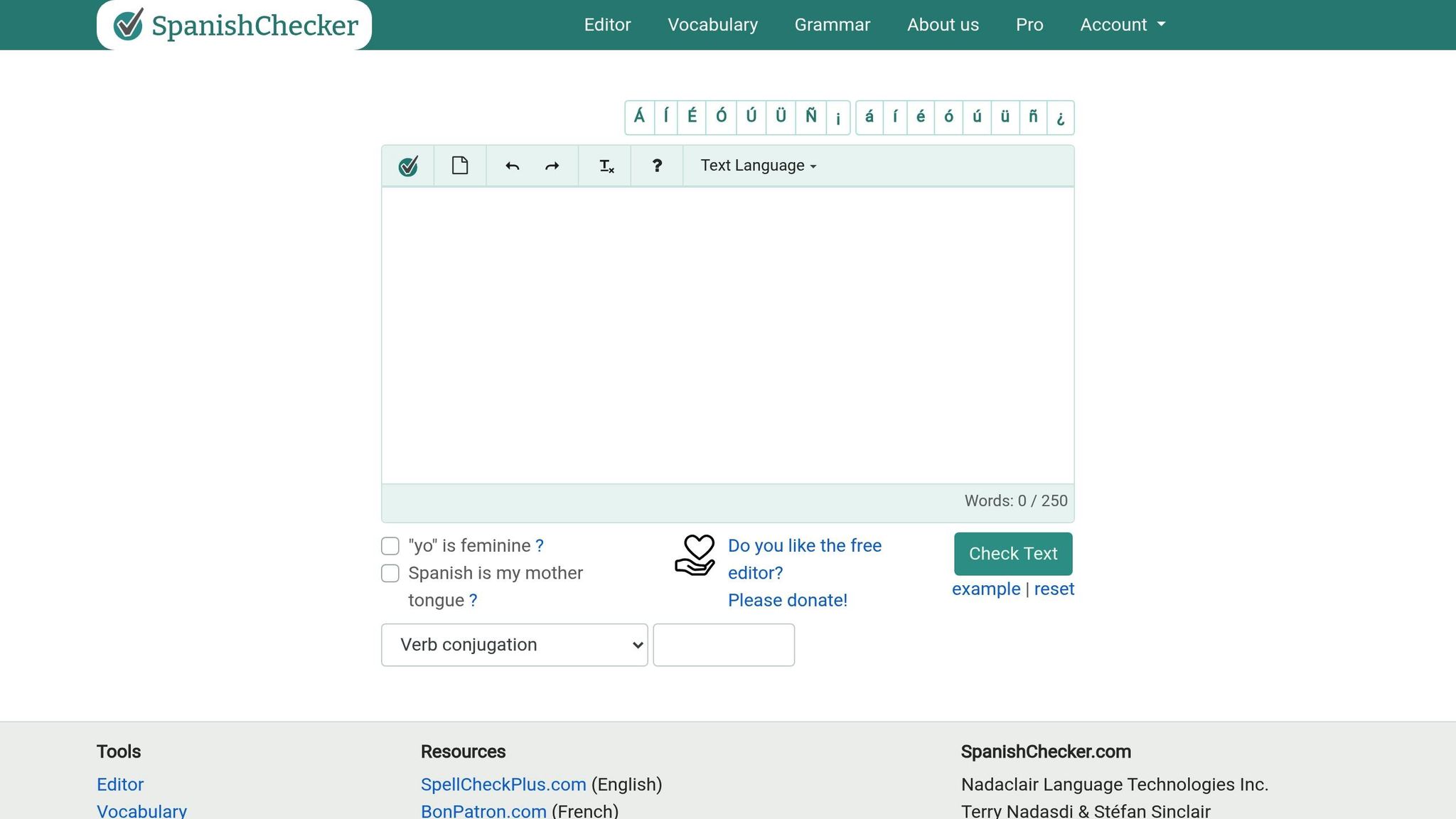
SpanishChecker.com is a grammar tool designed specifically for learners of Spanish as a Second Language (SSL). Unlike broader writing tools, it hones in on the unique challenges SSL learners face, offering targeted support to address common mistakes[13].
Grammar Correction Quality
This platform identifies three main types of errors: misspellings, verifiable structures, and corrections[12]. It’s particularly adept at catching frequently confused words. Alongside highlighting errors, the tool provides detailed feedback on spelling, grammar, and style[7]. Users can even customize suggestions by specifying their pronoun gender and whether they are native speakers or not[7].
Type of Tool
SpanishChecker functions as an online grammar and spell checker with an educational twist[14]. Instead of automatically fixing issues, it encourages active learning by flagging errors and offering suggestions, leaving users to make corrections themselves before resubmitting their work[12]. The Pro version adds extra value by including interactive exercises based on specific errors, detailed error summaries, and a writing portfolio feature[11].
Suitability for Proficiency Levels
This tool is effective for learners at all levels. Beginners benefit from its straightforward error identification and suggestions, while intermediate users gain insights into grammar patterns through its detailed feedback. Advanced learners, on the other hand, can use the Pro version’s exercises to refine their writing further. Its focus on SSL ensures it addresses the specific hurdles non-native speakers often encounter.
Accessibility
SpanishChecker has a user-friendly web interface where users can paste their text directly for analysis[6]. The free version allows up to 500 words per submission, making it ideal for short assignments and practice exercises[12]. No registration is needed for basic use, but creating an account unlocks additional features. The Pro version is available for $16 per year, while classroom licenses for educational institutions cost $299 for up to 30 students[11]. This specialized approach makes SpanishChecker a standout resource for Spanish grammar practice.
4. Reverso
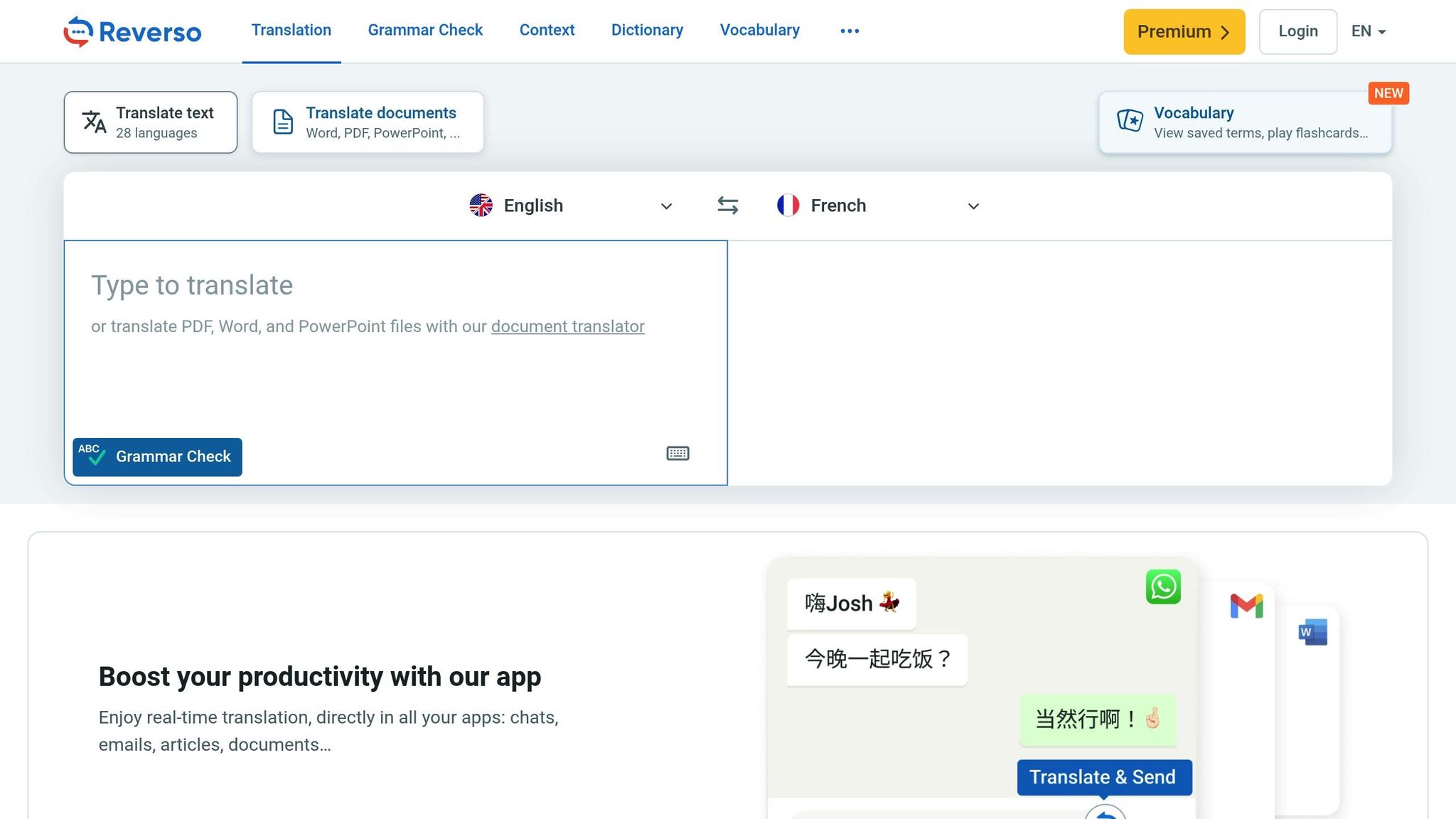
Reverso is an AI-powered language tool trusted by over 96 million users around the globe[15]. Designed to do more than just correct grammar, it also provides contextual translations, making it a fantastic resource for Spanish learners looking to improve both their writing and understanding of practical language use.
Type of Tool
Reverso is more than a basic grammar checker - it's a versatile language platform. It offers tools like spelling and grammar correction, style suggestions, and a rephraser to improve sentence flow. On top of that, it includes a dictionary, contextual translation examples, pronunciation guides, and synonym suggestions, making it an all-in-one solution for anyone looking to refine their language skills.
Grammar Correction Quality
Powered by AI, Reverso's grammar checker accurately spots and corrects common issues such as incorrect verb tenses, subject-verb agreement errors, misplaced prepositions, and punctuation slip-ups. What sets it apart is its ability to provide multiple correction options when applicable, helping users not only fix mistakes but also understand the reasoning behind them. Its style and synonym suggestions further enrich the user's vocabulary and improve writing quality.
Suitability for Proficiency Levels
Reverso caters to learners at every stage. Beginners will find its straightforward error corrections and contextual examples helpful for grasping the basics. Intermediate users can experiment with the rephraser to discover alternative ways of expressing ideas, while advanced learners can refine their writing with nuanced style suggestions and vocabulary enhancements to achieve a more polished tone.
Accessibility
Reverso is available on multiple platforms, including web, mobile apps, Windows, and browser extensions, offering flexibility for users. The free version allows you to check up to 900 characters, though registration is required for texts longer than 360 characters. Signing up is simple and can be done via email or third-party accounts like Google, Facebook, or Apple. For those needing more robust features, a premium subscription unlocks additional capabilities for intensive use.
5. Scribbr
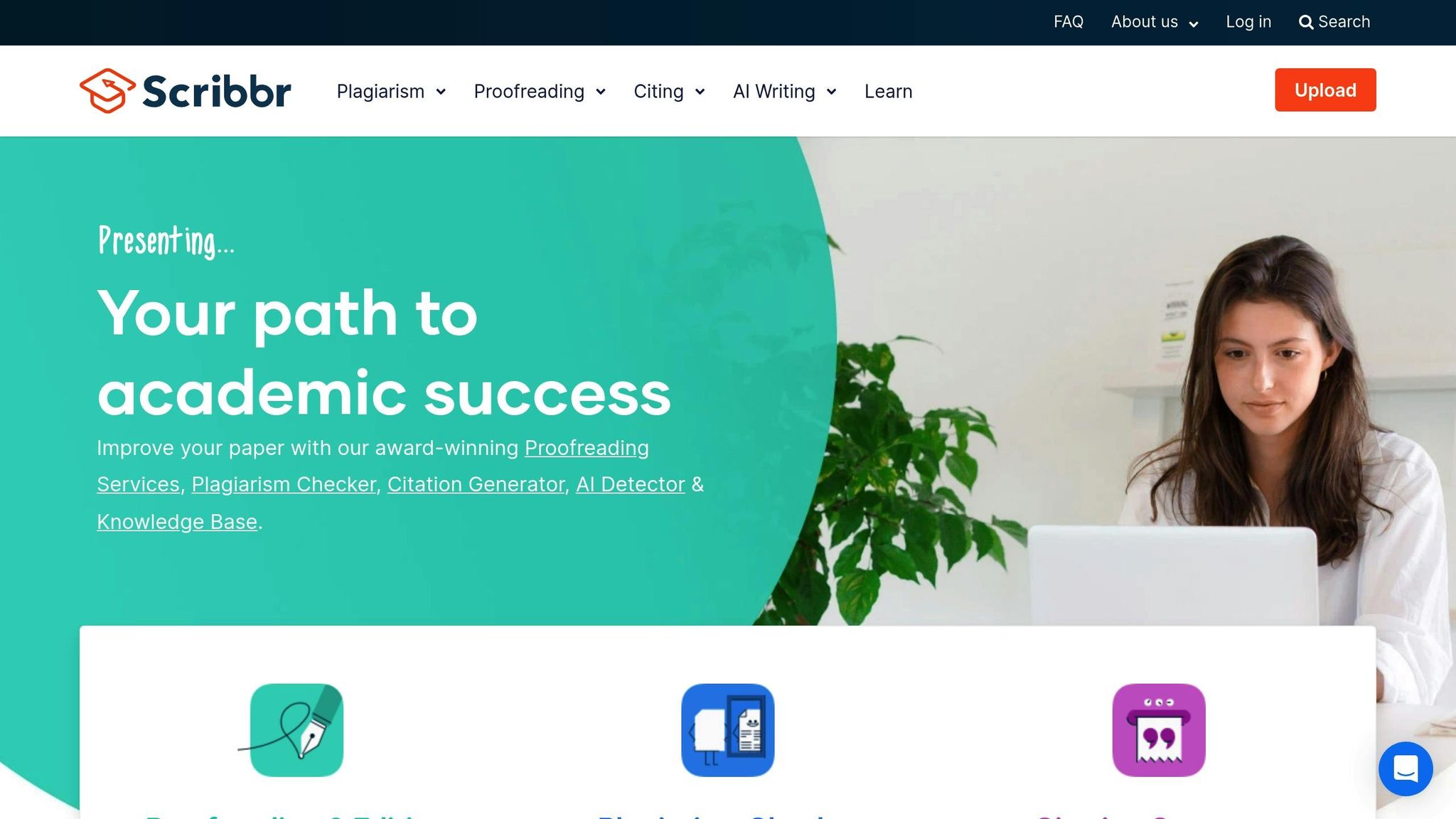
Scribbr provides a free Spanish grammar checker powered by QuillBot technology, known for its precision and user-friendly interface.
Type of Tool
This tool goes beyond basic grammar checks. It identifies simple spelling mistakes and advanced grammar issues while offering additional features like a paraphrasing tool, a summarizer, and a paragraph rewriter with a "Fluency" mode. For those wanting detailed feedback, Scribbr also has a paid proofreading service handled by native Spanish-speaking editors. Let's take a closer look at how well it performs in error detection.
Grammar Correction Quality
Scribbr's grammar checker stands out for its ability to handle tricky errors. It effectively identifies issues like the misuse of ser vs. estar, por vs. para, and missing accents. In tests, it caught 19 out of 20 errors[16], demonstrating its strength in addressing both straightforward and more complex grammar problems.
Suitability for Proficiency Levels
This tool is designed to assist learners at every level. Beginners benefit from clear explanations of their mistakes, intermediate users can refine their writing with the "Fluency" mode, and advanced learners receive detailed corrections and style recommendations. The paragraph rewriter is especially popular, earning a 4.5-star rating from over 15,000 reviews[18].
Accessibility
Scribbr’s grammar checker is fully web-based, ad-free, and doesn’t require any downloads. It works smoothly on both desktop and mobile devices, and no sign-up is necessary[17]. If you need additional help, support is available through chat, WhatsApp, email, and phone.
sbb-itb-dfae180
6. My Stilus

My Stilus is a Spanish grammar checker designed to provide detailed feedback on grammar, style, and typography.
Type of Tool
My Stilus functions as an interactive proofreading tool with four distinct levels of text analysis: spelling, orthotypography, grammar, and style checks[19]. Unlike tools that automatically rewrite content, My Stilus lets you stay in control by allowing you to review and accept suggestions manually[19]. It’s available as a web-based platform and as an add-in for Microsoft Word[6]. One standout feature is its ability to differentiate between various Spanish dialects, such as Mexican, Caribbean, and Central American variants[20]. This makes it especially helpful for learners focusing on regional Spanish nuances. Its structured design ensures value for users at all proficiency levels.
Grammar Correction Quality
Powered by natural language processing, My Stilus goes beyond basic pattern matching to detect contextual errors[19]. Its 7-million-word lexical database, which includes 190,000 proper nouns, ensures accurate corrections across a wide range of text types[19]. It also checks typography and style, catching issues like misplaced punctuation, incorrect accent marks, and stylistic inconsistencies.
Suitability for Proficiency Levels
My Stilus caters to users at varying skill levels with its four-tier proofreading system. Beginners can focus on spelling and orthotypography, while intermediate users can work on refining sentence structures and verb conjugations. Advanced users benefit from the style-checking feature, which helps polish their writing to a professional standard[19]. The tool also allows customization for specific Spanish dialects and dictionaries, making it particularly useful for those learning or working with regional variations of the language[21].
Accessibility
My Stilus offers a free demo mode that allows users to proof up to 5,000 words per month, giving you a chance to explore its features without committing to a subscription[19]. For extended use, subscription options include Stilus Gold at approximately $32.95 per year and Stilus Platinum at around $65.95 per year[6]. To use the Microsoft Word integration, you’ll need to create an account with your email and password[19]. While the web version is compatible with most browsers, there’s no dedicated mobile app currently available. The service has earned positive reviews, holding an overall rating of 4.5 out of 5[6].
7. Practical Spanish
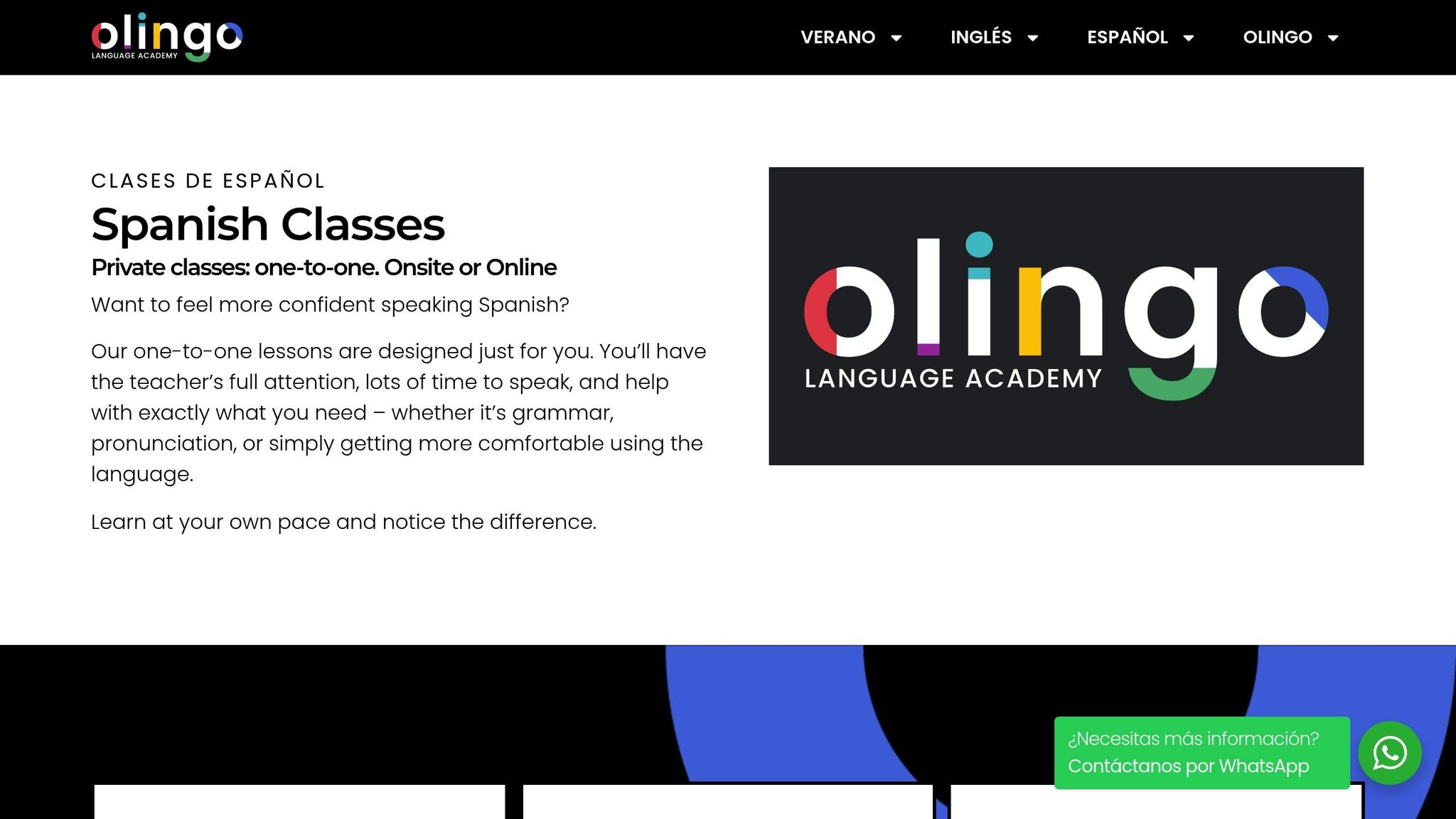
Practical Spanish is a grammar-focused platform that pairs straightforward explanations with engaging video content to help learners grasp grammar concepts effectively. Also called "Spanish Grammar in Context", it showcases grammar rules through real-world video examples, giving learners a glimpse of how these rules come to life in actual conversations[22].
Type of Tool
Practical Spanish serves as an interactive learning resource, offering a mix of lessons, videos, and reading exercises[23]. Each topic is broken down with clear explanations and reinforced through online quizzes[22]. To enhance the learning experience, the platform combines text-based tutorials with audio clips, ensuring learners can hear and practice native pronunciation[24].
Suitability for Proficiency Levels
This platform is designed for learners at all stages, from beginners to advanced speakers[23]. Content is neatly organized by skill level: beginners can build a solid foundation, while intermediate and advanced users can dive into more complex structures and subtle language nuances.
Accessibility
Practical Spanish is completely free and available online[23]. It emphasizes Latin American Spanish, making it an excellent choice for those focusing on this dialect[24]. Its user-friendly web format ensures that lessons are accessible from any device with an internet connection, offering flexibility for learners on the go.
8. Forvo
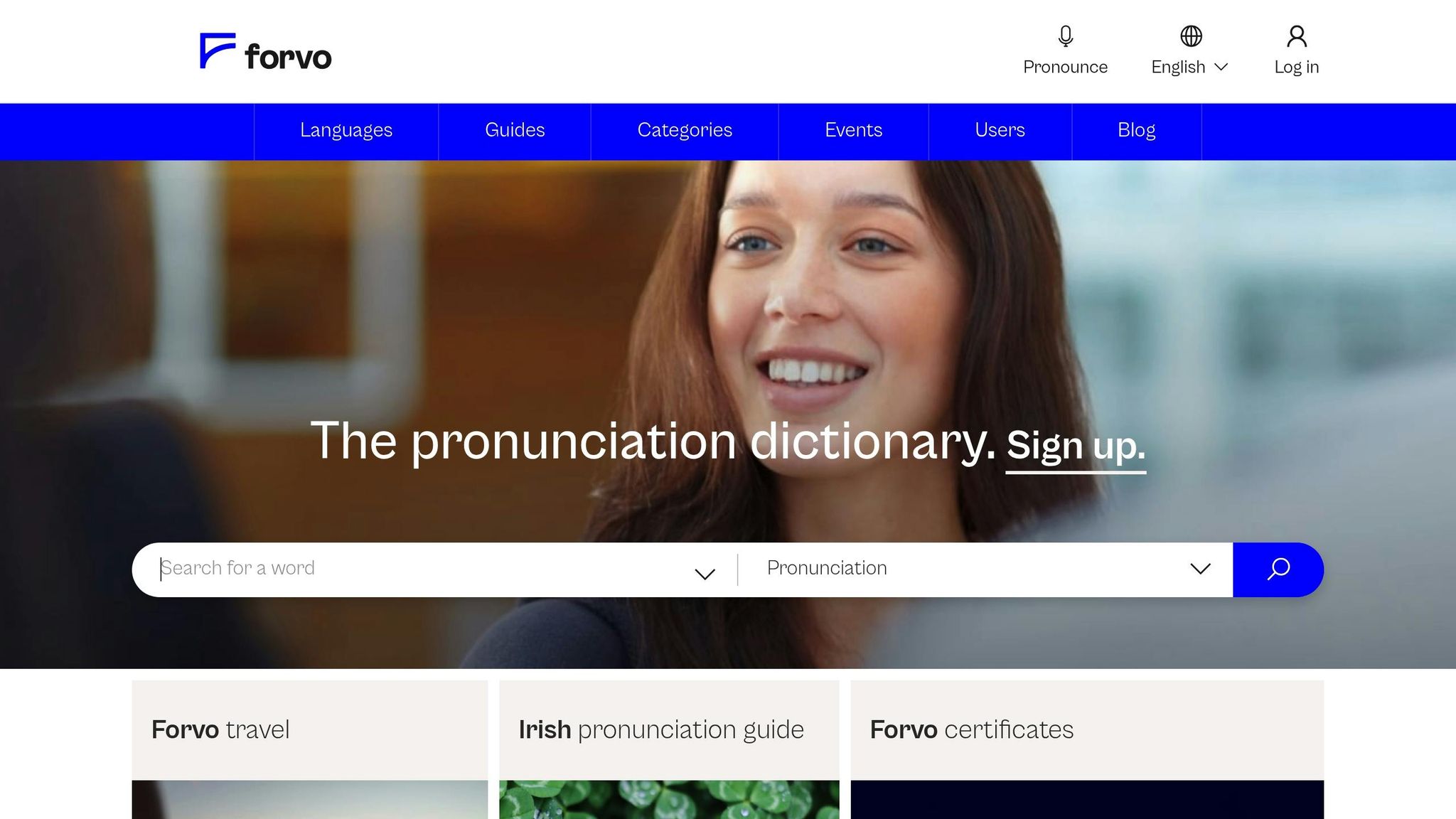
Forvo connects Spanish learners with native speakers worldwide, creating a rich collection of authentic voice recordings. Registered users contribute these recordings, building a library of native pronunciations. While it doesn’t function as a traditional grammar checker, Forvo plays a key role in helping learners grasp how Spanish words should sound in real-life conversations. The platform boasts nearly 6 million pronunciations across more than 430 languages[28]. Each audio clip offers clear examples of pronunciation, and users can compare regional accents for the same word. This feature is especially helpful for understanding the variations found in different Spanish-speaking countries[27].
Type of Tool
At its core, Forvo is an interactive pronunciation dictionary with added learning tools[23]. Beyond its extensive pronunciation database, it includes an eLearning section that provides structured courses. These courses focus on teaching useful words and phrases while ensuring learners hear accurate pronunciations in context[25]. The content is organized into practical categories, making it easier for users to systematically improve their Spanish pronunciation skills[23].
Suitability for Proficiency Levels
Forvo is especially helpful for beginners and intermediate learners who are still tuning their ear to Spanish sounds[23]. Beginners can start with basic vocabulary, while intermediate users can tackle more complex terms. A standout feature is the ability to request pronunciations for words not yet included in the database, making it a valuable tool when encountering unfamiliar terms[28]. Advanced learners, on the other hand, might not rely on Forvo as much for daily practice, as they often benefit more from engaging with native content. However, the platform can still be useful for verifying specialized vocabulary or exploring regional accent differences[23].
Accessibility
Forvo is a free web-based service with optional premium features[26][28]. The free version includes ads, while the premium plan - available for just $2 (one-time or annually) - removes ads and prioritizes pronunciation requests[28]. Forvo is accessible via its website and mobile apps for iOS and Android, making it convenient for learners to check pronunciations anytime, anywhere[28]. The iOS app currently has a 3.3 out of 5 rating based on 9 reviews, reflecting mixed feedback on the mobile interface[27].
9. Microsoft Word Spanish Grammar Check
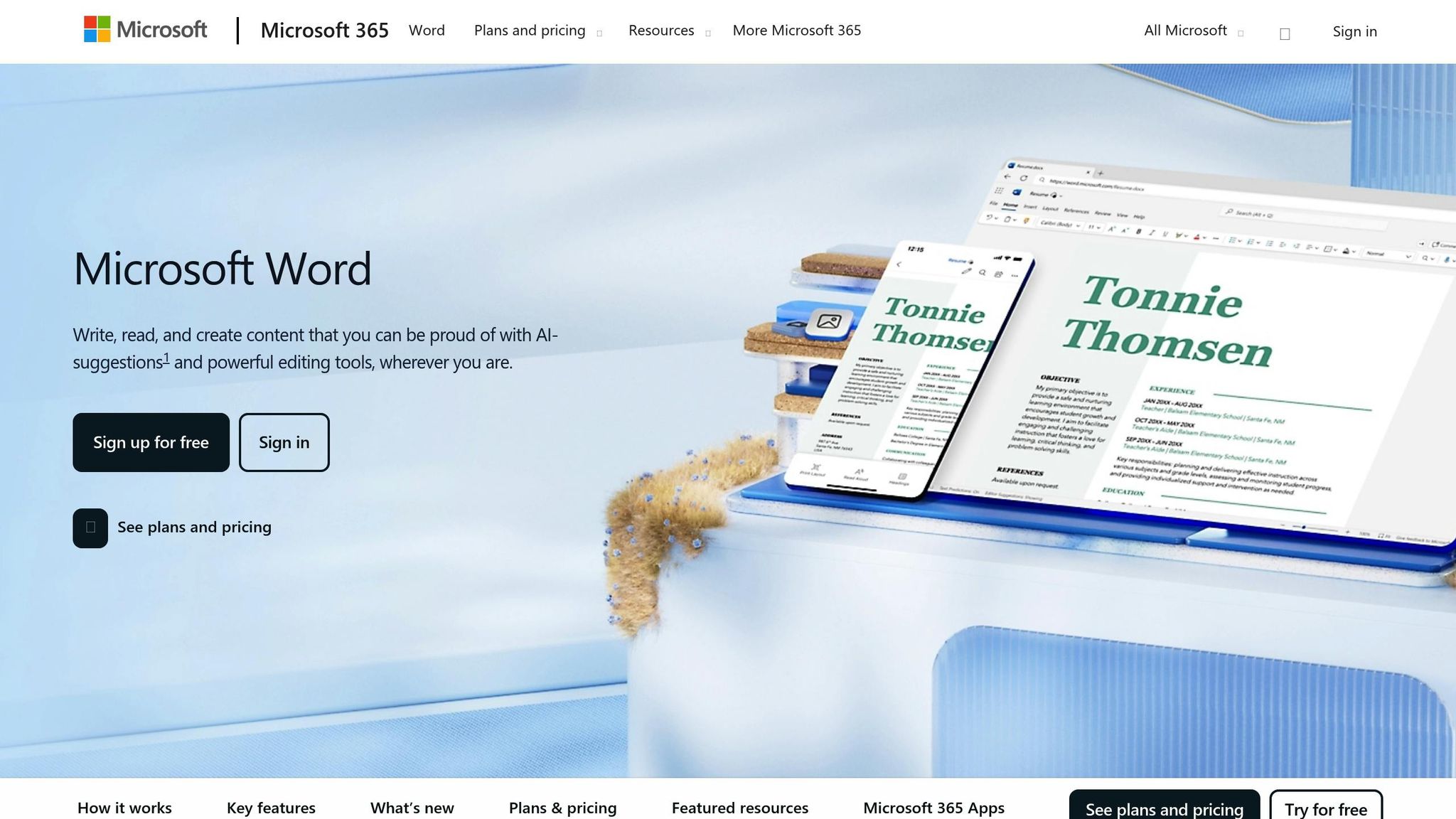
Microsoft Word comes with a built-in Spanish grammar check that automatically identifies Spanish text and suggests corrections for spelling, grammar, and style. Since it's part of Word's core functionality, you can use it without switching between applications, making it a convenient option for students, professionals, and writers.
The tool works by analyzing your text, underlining potential issues, and offering suggestions for corrections. While Microsoft continues to improve the Editor's capabilities, some users and experts have raised concerns about its accuracy.
Grammar Correction Quality
The effectiveness of Microsoft Word's Spanish grammar check varies. It provides suggestions for spelling, grammar, and style - like simplifying sentences or improving word choice - but it often struggles with more complex grammatical rules.
As John Thiesmeyer, an English professor, puts it:
"I think it's because it's only a glorified (by Microsoft) spelling checker. Spelling checking is easy; grammar checking is hard, and Microsoft has put very little effort into it."
The tool is better at catching basic errors than addressing deeper linguistic nuances. It may also overlook regional vocabulary differences or misinterpret sentence structures, leading to incorrect suggestions. This makes it less reliable for texts requiring a nuanced understanding of Spanish grammar.
How the Tool Works
As a real-time checker, Microsoft Word's Spanish grammar tool reviews your text as you type. It highlights potential issues with underlines and offers pop-up suggestions for corrections. You can customize the types of issues it reviews, tailoring the tool to suit your specific needs. This integration into the writing process ensures immediate feedback without disrupting your workflow.
Who Can Benefit?
This tool is designed for users at all skill levels. Beginners will find its basic corrections helpful, though they should be cautious about relying on it entirely, as it doesn't always explain errors in detail. Intermediate users can use it as a first step before proofreading more thoroughly, while advanced users may appreciate its ability to catch minor mistakes but will still need to manually review for more complex grammatical nuances.
Accessibility
Microsoft Word's Spanish grammar check is available across multiple platforms. Basic functionality is free with a Microsoft account, but advanced grammar and style features require a Microsoft 365 subscription. You can access the tool on Windows, Mac, web browsers, and mobile devices (iOS and Android).
The web version offers essential editing tools, while the mobile app includes similar features at no extra cost. For full desktop functionality, you’ll need either a Microsoft 365 subscription or a standalone Office version like Office 2019 or Office 2016.
To use the Spanish grammar check effectively, make sure to set Spanish as your proofing language in Word's settings. Enabling the "Detect language automatically" feature can also be helpful for documents containing multiple languages. Since this tool is built into one of the most widely used word processors, it’s a practical option for everyday grammar checks, even if it’s not perfect for every situation.
10. Spanish Language Learning Apps Grammar Section
Spanish Language Learning Apps (https://spanishlanguagelearningapps.com) offers a robust grammar section that blends interactive lessons, quizzes, and AI-driven personalization to help users conquer Spanish grammar.
This section highlights some of the top apps that use gamification and practical scenarios to make grammar learning engaging. For instance, LingoDeer includes gamified lessons enriched with clear grammar notes, while Ella Verbs focuses on mastering Spanish verb conjugations with over 30 levels, covering 2,300+ verbs and 16 tenses. Qué Onda emphasizes real-world applications with lessons rooted in everyday situations, and LENGO provides grammar exercises designed to keep learning enjoyable.
Type of Tool
The platform takes a multi-faceted approach to grammar learning, combining lessons, conjugation drills, quizzes, and games into a single ecosystem. For example, Ouino includes over 450 lessons and 1,300 games, while Lexiforms specializes in conjugating more than 7,000 verbs.
Many tools feature AI tutors and personalized study plans that adapt to your strengths and weaknesses. Placement tests are often included to evaluate grammar, reading, and listening skills, allowing the apps to tailor learning paths to your specific needs.
Suitability for Proficiency Levels
The grammar section accommodates learners at all levels, following the CEFR (Common European Framework of Reference for Languages), which classifies proficiency from A1 (beginner) to C2 (advanced). Content is broadly divided into three categories: beginner (A1-A2), intermediate (B1-B2), and advanced (C1-C2).
For beginners, Language Drops offers quick, illustrated lessons that teach basic grammar concepts in just five minutes a day. On the other hand, advanced learners can benefit from SpanishPod101, which provides in-depth audio and video lessons covering complex grammar topics like nuanced conjugations.
The standout feature of the platform is its customized learning experience. Placement tests identify your current level and highlight areas for improvement, allowing the apps to adjust content specifically for you. This adaptability ensures a smooth learning experience, whether you're studying at home or on the go.
Accessibility
The grammar section is fully web-based and mobile-friendly, with apps available for both iOS and Android devices. Most apps require users to sign up, offering options to register via email, Google, or Facebook.
Pricing for these apps typically starts under $10 per month, and many provide free trials or limited free content before requiring a subscription for full access.
The platform prioritizes device compatibility, ensuring that most apps work seamlessly across smartphones, tablets, and desktops. This flexibility allows you to practice Spanish grammar wherever you are - whether you're commuting, relaxing at home, or traveling - making it easier to stick to your study routine no matter your schedule.
How to Get Better Results from Grammar Practice
To make the most of the free Spanish grammar tools mentioned earlier, it’s important to pair them with effective strategies. By combining resources and focusing on patterns, you can create a study routine that’s both efficient and tailored to your needs.
Mix and Match Tools for Broader Coverage
No single grammar tool catches every type of mistake. For example, one might excel at spotting verb conjugation errors, while another is better at identifying punctuation mishaps. Using multiple tools together ensures a wider range of errors is addressed [7]. This works because each tool relies on unique algorithms and databases, giving you a more complete picture of your writing.
Understand the Errors, Don’t Just Correct Them
Fixing mistakes is helpful, but learning why they’re wrong takes your practice to the next level. Many Spanish grammar tools now provide explanations alongside corrections, making it easier to understand the rules behind the fixes [4].
"LexiCheck is not just a Spanish spell checker - it teaches as it corrects. AI offers instant, short explanations of why something is wrong, so you learn the rule, not just the fix." [4]
Take time to study these explanations. Keeping a personal error log can also be a game-changer. By tracking your most frequent mistakes, you’ll spot patterns and know exactly where to focus your efforts.
Practice with Varied Texts
Once you’re comfortable correcting errors, challenge yourself with different types of content. Alternate between short, simple sentences and longer, more complex passages. Short texts let you zero in on specific grammar rules, while longer ones test your ability to maintain accuracy and consistency across more complicated sentence structures.
Use Feedback in Both English and Spanish
If a tool offers bilingual feedback, take advantage of it. Feedback in English can clarify tricky concepts when you’re starting out, while Spanish explanations encourage you to think more naturally in your target language. This dual approach helps bridge the gap between your native language and Spanish grammar, sharpening your skills along the way [30].
Monitor Your Progress
Many grammar tools now include features that track your development over time. Metrics like error frequency and the types of corrections applied can show you where you’re improving and where you still need work [10]. Regularly reviewing these insights allows you to adjust your study plan and focus on weaker areas.
Incorporate Real-World Materials
Dive into authentic Spanish content like news articles, books, or movies. Real-world materials show you how grammar rules play out in everyday language use [29]. When you come across unfamiliar structures, use your grammar tools to break them down and learn from them. This combination of tool-based learning and real-life exposure builds a solid foundation for fluent communication in Spanish.
Conclusion
Free Spanish grammar tools provide a practical and accessible way to strengthen your grasp of Spanish grammar without spending a dime. These tools not only clarify grammar rules but also provide examples that help you understand both the corrections and the reasoning behind them [31]. Many even incorporate game-like features, turning grammar practice into a fun and engaging activity [32].
What makes these tools especially appealing is their flexibility. You can fit learning into your own schedule, making them a convenient option for busy learners [32]. They also offer a stress-free environment to pick up new vocabulary and get comfortable with Spanish sentence structures. This gradual approach helps you build confidence before tackling more advanced materials [32].
To get the most out of these resources, it’s worth experimenting with different tools to find the ones that suit your learning style best. Pairing these tools with immersive activities, like language exchanges or using authentic Spanish content, can further enhance your progress [32] [2].
FAQs
To choose the best Spanish grammar tool, start by assessing your current skill level and what you want to achieve. If you're a beginner, look for tools that break down grammar concepts clearly and offer interactive exercises to help you grasp the basics. For intermediate or advanced learners, opt for resources that dive deeper, providing detailed grammar practice and lessons designed for higher levels of fluency.
Think about your specific goals. Are you aiming to improve your conversation skills, refine your grammar, or get better at reading and writing? Pick tools that match your learning style - whether that's through interactive apps, quizzes, or well-structured courses - to keep you engaged and on track to meet your goals.
Yes, certain Spanish grammar tools are built to account for regional dialects. They can distinguish between variations like Castilian Spanish, spoken in Spain, and Latin American Spanish. These tools adjust their recommendations and corrections to match the grammar, vocabulary, and expressions specific to each dialect, making them especially helpful for learners targeting a particular region.
To make the most of free Spanish grammar tools, incorporate them into your daily learning routine. Set aside time regularly to practice and fully engage with these resources through exercises, quizzes, or interactive lessons. Pair these tools with hands-on activities like writing short paragraphs, speaking aloud, or practicing conversations to solidify your understanding.
For even stronger results, immerse yourself in the language. Watch Spanish TV shows, listen to podcasts, or read simple articles - these activities help you see grammar in action and make it easier to remember. The secret to mastering grammar and boosting your overall language skills lies in consistency and applying what you learn in real-life situations.

